Growing Living Stones (Lithops) Indoors
Botanical Name: Lithops species
Living Stones are flowering succulents that blend into their native environment because they grow in a stemless clump resembling small stones.
Their fleshy, swollen leaves are often green, gray or brown with mottled markings. Although some species may be bright green, red, pink, orange, blue-green or any combination.
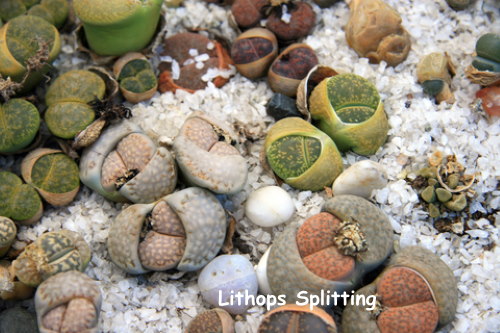 Lithops split open to reveal new pairs of leaves. Photo © Lali Kacharava
Lithops split open to reveal new pairs of leaves. Photo © Lali KacharavaThey split across the top with big, daisy-like flowers emerging in fall. The flowers don't last long, but they add a burst of color to the natural stone shades; they may be bright yellow or white, depending on the species.
Lithops may not bloom for the first 2-3 years, so be patient. It is a long-lived plant and is fascinating to watch through its growth cycle.
Once the flowers fade, the leaves will open and a new pair of leaves will push up through the split to replace them.
Repotting lithops is only necessary every 5 years or so, when the plants become crowded in the pot. Use a pot 6 in (15 cm) deep because this plant grows long taproots.
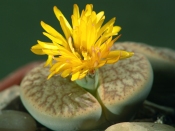
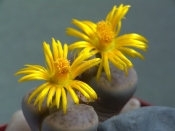
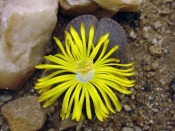
Lithops Species
Many varieties are available. You'll find each Lithops species for sale by its scientific name: Lithops karasmontana has mottled brown markings with white flowers, Lithops marmorata is grayish-brown with white flowers and Lithops aucampiae is brown with reddish-brown markings and yellow flowers.
Mix them up for an attractive display. Grow 2 or 3 species in the same pot. Or pot them up in matching containers to group together. Surround them with pebbles for decoration.
Living Stones Care Tips
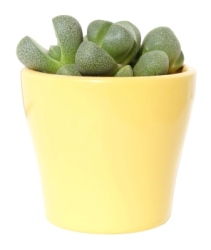
Origin: South Africa
Height: Up to 2 inches (5 cm)
Light: In summer, give Lithops plenty of bright light, with at least 4 hours of direct sun a day. A sunny windowsill is an ideal spot for it. From fall through spring, give it indirect light.
Water: Be careful not to overwater lithops and provide good drainage. This succulent stores moisture and nutrients in its leaves, and its roots will rot if kept too wet. Aim to keep soil barely moist from spring through fall, allowing the top half of the soil to dry out between waterings. Do not water after the flowers have faded and the leaves begin to shrivel. Resume watering the following spring.
Humidity: Average room (around 30-40% relative humidity) or lower.
Temperature: Keep Lithops warm to hot in summer (70°-90°F/21°-32°C). Autumn through spring, cool to average (60°-70°F/16°-21°C). Go ahead and put it outdoors, if you want. Just bring it back inside when the temperature drops. It will tolerate a minimum temperature of 50°F/10°C.
Soil: Cactus potting mix is the best for Lithops because it is fast-draining -- ideal for this water-storing succulent.
Fertilizer: Feed once in spring and once in fall with a balanced water-soluble fertilizer.
Propagation: Seeds, or divide clumps in early summer. To sow seeds, sprinkle seeds on top of moistened potting mix and barely cover with additional mix. Use a container with drainage holes. Place container in a warm, sunny window. Mist with water occasionally; seedlings will appear in a few weeks.


